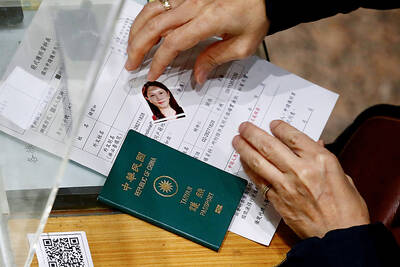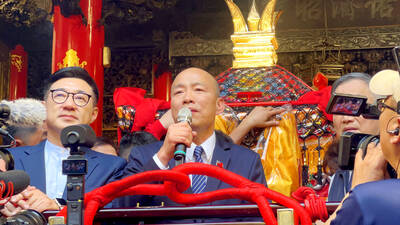Located near Taipei Train Station, Ri Xing Typography (日星鑄字行) looks like any of the other unprepossessing workshops and offices on its small side street. But the tiny factory houses one of Taiwan’s treasures — the last complete set of traditional Chinese character molds for lead-type casting in the world.
The lead type is used for movable type, a printing process that has been largely superseded by newer techniques. So Chang Chiehkuan (張介冠), whose parents founded Ri Xing Typography in 1969, plans to bring his family’s legacy into the 21st century by digitizing Ri Xing’s typefaces and turning the factory into a museum.
“Our most important goal right now is to preserve our industry by letting people come here and experience movable type for themselves. That’s our biggest dream,” says Chang.
Ri Xing Typography is one of the last factories in Taiwan to produce traditional Chinese character lead type (the other, Chung Hsing Typography (中新鑄字行) in Kaohsiung, was founded by Chang’s uncle). The facility looks much as it did 40 years ago. A steady, rhythmical thumping emanates from its type-casting machines and flows through rows of shelves upon which thousands of pieces of lead type, representing every Chinese character and dozens of symbols, are stacked.
Movable type may be 1,000 years old (and Chinese characters are, of course, much older than that), but Chang hopes that he can make the printing method relevant to a new generation by turning Ri Xing lead type into computer fonts and making the typefaces compatible with newer printing methods. The digitization is one part of Ri Xing Typography’s restoration and preservation plan (日星鑄字行活版字體復刻暨保存計畫) Chang launched last fall. The second part is turning the factory into a museum where visitors can experience movable type hands on.
The project is a monumental one and Chang expects it will take at least 10 years to complete. Ri Xing’s lead type comes in three different fonts, most of which are available in seven different sizes, giving Ri Xing a total collection of a whopping 200,000 molds. Chang estimates it will take two to three years just to scan, upload and edit every character.
His dedication is spurred on by the fact that Taiwan is the last country in the world to use traditional Chinese characters as its standard writing system. And he believes Ri Xing’s lead type, made from molds that were originally hand-carved, captures the spirit of Chinese writing better than computer fonts.
Normally laid-back, Chang becomes effusive when showing visitors charts comparing characters printed with the shop’s kaishu (楷書, or standard script, a style of Chinese calligraphy) lead type and a font found in most word processing programs. (The two other styles available as lead type in Rixing are songti (宋體), a non-calligraphic font, and the bold heiti (黑體).)
“I think that when you compare them side by side, you can see right away that words printed with lead type are much lovelier because they are able to preserve the beauty of Chinese calligraphy and the grace of its individual brush strokes. Right now that is something you can’t find in computer fonts, in our opinion,” says Chang, who grew up surrounded by printing presses. “My parents have worked in this industry for 70 years, so I was immersed in it as soon as I was born. As a result, I feel very deeply about type.”
Chang’s ultimate goal may be to transform Ri Xing into a museum, but it is still an active business with clients, many of whom have ordered lead type from the factory for decades. Ri Xing’s customers are usually smaller print shops that produce specialty items, such as movie tickets or forms with serial numbers. Their proprietors dug their heels in two decades ago when Taiwan’s printing industry began to abandon movable type in favor of faster methods like offset printing.
“These older business people didn’t want to follow the rest of the industry and change what they were doing. They still use movable type, so I stay here and work with them so they can get the supplies they need,” says Chang.
Now Ri Xing Typography is garnering a new, but equally dedicated, group of supporters. Many of these fans are graphic designers who were drawn by media reports on Ri Xing. Some now volunteer with the digitization project, including Mu-han Chiu (邱睦涵), a freelance designer who first saw photos of Ri Xing’s lead type online.
“It is important to our culture. Taiwan and Hong Kong are the last places to actually use traditional Chinese character typeface, and it would be a shame to let this ancient form of writing disappear,” says Chiu. The 30 or so volunteers aren’t just designers, she adds — they include computer programmers and a bookstore owner.
“There are a lot of people who are passionate about this project,” says Chiu.
The Ri Xing plan is still a long way from being realized, but it has already received a fair amount of publicity in the Taiwanese media, thanks in part to a visit to the factory by President Ma Ying-jeou (馬英九) in June. Ri Xing is open to visitors for a few hours each week, and individual lead type can be purchased for NT$1 to NT$80 per piece. Its gifting potential is increased by the fact that the Taiwanese pronunciations of lead type (鉛字) and the fate that draws people together (緣份) sound alike.
“Chinese characters have a very long history and they are always evolving,” says Chang. “As long as they keep transmitting culture and knowledge, as well as their own individual meanings, then they are already fulfilling their purpose. It doesn’t matter what they look like, but we think lead type really brings out their beauty.”

April 14 to April 20 In March 1947, Sising Katadrepan urged the government to drop the “high mountain people” (高山族) designation for Indigenous Taiwanese and refer to them as “Taiwan people” (台灣族). He considered the term derogatory, arguing that it made them sound like animals. The Taiwan Provincial Government agreed to stop using the term, stating that Indigenous Taiwanese suffered all sorts of discrimination and oppression under the Japanese and were forced to live in the mountains as outsiders to society. Now, under the new regime, they would be seen as equals, thus they should be henceforth

Last week, the the National Immigration Agency (NIA) told the legislature that more than 10,000 naturalized Taiwanese citizens from the People’s Republic of China (PRC) risked having their citizenship revoked if they failed to provide proof that they had renounced their Chinese household registration within the next three months. Renunciation is required under the Act Governing Relations Between the People of the Taiwan Area and the Mainland Area (臺灣地區與大陸地區人民關係條例), as amended in 2004, though it was only a legal requirement after 2000. Prior to that, it had been only an administrative requirement since the Nationality Act (國籍法) was established in

Three big changes have transformed the landscape of Taiwan’s local patronage factions: Increasing Democratic Progressive Party (DPP) involvement, rising new factions and the Chinese Nationalist Party’s (KMT) significantly weakened control. GREEN FACTIONS It is said that “south of the Zhuoshui River (濁水溪), there is no blue-green divide,” meaning that from Yunlin County south there is no difference between KMT and DPP politicians. This is not always true, but there is more than a grain of truth to it. Traditionally, DPP factions are viewed as national entities, with their primary function to secure plum positions in the party and government. This is not unusual

US President Donald Trump’s bid to take back control of the Panama Canal has put his counterpart Jose Raul Mulino in a difficult position and revived fears in the Central American country that US military bases will return. After Trump vowed to reclaim the interoceanic waterway from Chinese influence, US Defense Secretary Pete Hegseth signed an agreement with the Mulino administration last week for the US to deploy troops in areas adjacent to the canal. For more than two decades, after handing over control of the strategically vital waterway to Panama in 1999 and dismantling the bases that protected it, Washington has